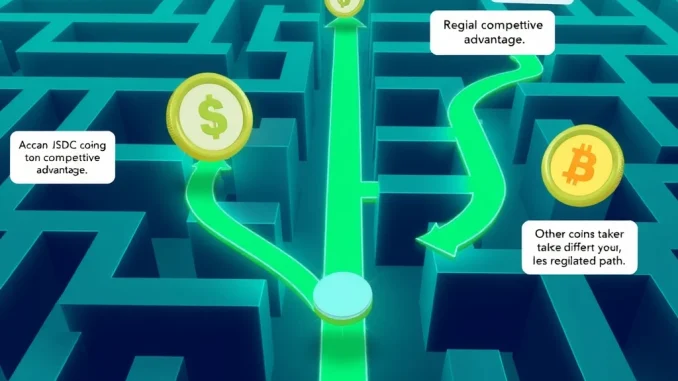
In the fast-evolving world of cryptocurrency, stablecoins are emerging as crucial players, bridging the gap between traditional finance and the decentralized digital economy. Among these, USD Coin (USDC), issued by Circle, has positioned itself as a leading contender. But in a recent analysis, Kevin Lehtiniitty, a key figure in the development of TrueUSD (TUSD), suggests that for Circle to not just compete but truly dominate, securing a regulatory advantage is not just beneficial—it’s absolutely essential. Let’s dive into why this regulatory landscape is so critical for Circle and the future of USDC.
The Regulatory Tightrope: Circle’s Challenge in the Stablecoin Arena
Lehtiniitty’s insights, shared in an interview with The Block, paint a picture of a stablecoin battlefield where the rules of engagement are vastly different for players like Circle and Tether. Why is Circle at a potential disadvantage? It boils down to their operational models and the associated costs. Let’s break down the core issues:
- Costly Compliance: Circle operates under a more stringent regulatory framework compared to Tether. This means significant investments in licensing, staffing compliance teams, and lobbying efforts to navigate the complex legal landscape.
- Tether’s Lean Model: In contrast, Tether adopts a permissionless and arguably less regulated approach. This leaner model allows them to minimize operational costs, giving them a price advantage in the market.
- The ‘Cost of Distribution’: Lehtiniitty highlights that Circle’s regulatory expenses contribute to a higher “cost of distribution.” This essentially means it’s more expensive for Circle to operate and maintain USDC due to its commitment to regulatory compliance.
Think of it like this: Imagine two businesses selling similar products. One meticulously follows every safety regulation, ensuring top-notch quality and consumer protection, but at a higher cost. The other cuts corners on regulations, offering a cheaper product but potentially with more risk. In the stablecoin world, Circle is taking the high-road of regulation, which, while building trust, also comes with a hefty price tag.
Distribution Dilemma: Can Circle Carve Its Own Path Like PayPal?
Beyond regulatory costs, competitive advantage in the stablecoin market also hinges on distribution. Lehtiniitty points out another crucial challenge for Circle: the lack of a unique distribution channel compared to emerging competitors like PayPal. Let’s consider PayPal’s strategic move with PYUSD:
PayPal’s PYUSD: A Distribution Powerhouse
PayPal’s foray into stablecoins with PYUSD is a game-changer due to its inherent distribution network. Here’s why:
| Feature | Circle (USDC) | PayPal (PYUSD) |
|---|---|---|
| Distribution Network | Relies on crypto exchanges and integrations. | Directly integrated into PayPal’s massive user base and payment ecosystem. |
| User Accessibility | Requires users to engage with crypto platforms. | Seamlessly accessible to PayPal’s hundreds of millions of users. |
| Ecosystem Integration | Broader crypto ecosystem. | Deeply embedded within PayPal’s payment services. |
PayPal already has a vast, established user base and infrastructure. Integrating PYUSD directly into this ecosystem gives them an unparalleled competitive advantage in terms of distribution. Users can effortlessly access and utilize PYUSD within the familiar PayPal environment, reducing friction and boosting adoption. Circle, on the other hand, relies on building partnerships and integrations with various crypto platforms to expand USDC’s reach.
Stablecoins: Interchangeable Tech, Differentiated Strategy?
Lehtiniitty raises a fundamental point about the nature of stablecoins themselves: they are, technologically speaking, quite interchangeable. The underlying technology to peg a cryptocurrency to a fiat currency like the US dollar is relatively straightforward. This means that the real battleground isn’t necessarily in technological innovation, but in strategic positioning and market access. So, if the tech is similar, how can Circle truly stand out and maintain a competitive advantage?
The Regulatory Strategy: Circle’s Path to Dominance?
According to Lehtiniitty, Circle’s most viable path to sustained success isn’t just about improving technology or distribution alone. It’s about actively shaping the stablecoin regulation landscape in its favor. This is a bold and strategic approach, suggesting that Circle should focus on:
Actionable Insights for Circle: Shaping the Future of Stablecoin Regulation
- Proactive Lobbying: Circle needs to aggressively engage with regulatory bodies to advocate for policies that align with its compliant operational model. This means actively participating in discussions and shaping regulatory frameworks.
- Highlighting Regulatory Differences: Emphasize the risks associated with less regulated stablecoins like Tether, drawing attention to the importance of consumer protection and transparency – areas where Circle excels.
- Creating Barriers for Competitors: Strategically push for regulations that would make it more challenging for competitors with leaner, less compliant models to operate effectively, thus strengthening Circle’s relative market position.
- Building Trust through Compliance: Leverage its commitment to regulation as a key marketing differentiator, appealing to users and institutions who prioritize security and compliance in the crypto space.
Essentially, Lehtiniitty argues that by strategically influencing crypto regulation, Circle can create a playing field that favors its strengths and disadvantages its competitors. This isn’t just about playing by the rules; it’s about helping to write them.
The Power of Regulatory Influence: A Double-Edged Sword?
While pursuing a regulatory strategy could indeed give Circle a significant regulatory advantage, it’s also a complex and potentially risky path. Regulatory capture, where a company unduly influences regulations for its own benefit, can raise ethical questions and potentially stifle innovation in the broader crypto space. However, in a nascent and rapidly evolving industry like cryptocurrency, clear and well-defined regulations are crucial for long-term stability and mainstream adoption. Circle’s challenge is to advocate for regulations that not only benefit its own position but also contribute to a healthier and more trustworthy stablecoin ecosystem overall.
Conclusion: Navigating the Regulatory Maze for Stablecoin Supremacy
Kevin Lehtiniitty’s analysis underscores a critical reality for Circle and USDC: in the competitive stablecoin market, stablecoin regulation is not just a hurdle to overcome, but a strategic lever to be wielded. While Tether benefits from a less regulated environment and PayPal leverages its distribution might, Circle’s path to sustained dominance may well lie in its ability to shape a regulatory landscape that rewards compliance, transparency, and responsible innovation. The coming years will be crucial in determining whether Circle can successfully navigate this regulatory maze and secure the critical edge it needs to truly lead the stablecoin revolution.



